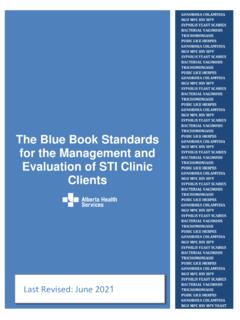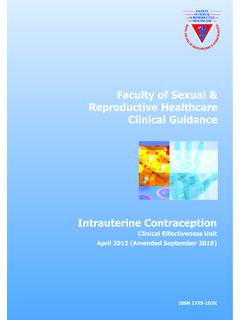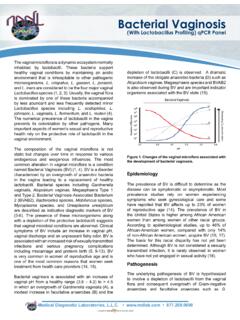Transcription of Sexually Transmitted Infections
1 Sexually Transmitted Infections Summary of CDC Treatment Guidelines 2021 bacterial vaginosis Cervicitis Chlamydial Infections EpididymitisGenital Herpes Simplex Genital Warts (Human Papillomavirus) Gonococcal InfectionsLymphogranuloma Venereum Nongonococcal Urethritis (NGU) Pediculosis PubisPelvic Inflammatory Disease Scabies Syphilis Department of Health and Human ServicesCenters for Disease Control and PreventionNational Center for HIV/AIDS, Viral Hepatitis, STD, and TB PreventionNational Network of STD Clinical Prevention Training CentersThis pocket guide reflects recommended regimens found in CDC s Sexually Transmitted Infections Treatment Guidelines, 2021. This summary is intended as a source of clinical guidance. When more than one therapeutic regimen is recommended, the sequence is in alphabetical order unless the choices for therapy are prioritized based on efficacy, cost, or convenience.
2 The recommended regimens should be used primarily; alternative regimens can be considered in instances of substantial drug allergy or other contraindications. An important component of STI treatment is partner management. Providers can arrange for the evaluation and treatment of sex partners either directly or with assistance from state and local health departments. Complete guidelines can be viewed online at booklet has been reviewed by CDC in July 2021. Accessible version: vaginosis Risk CategoryRecommended Regimen Alternatives metronidazole oral 500 mg orally 2x/day for 7 daysOR metronidazole gel , one 5 gm applicator intravaginally, 1x/day for 5 days OR clindamycin cream 2%, one 5 gm applicator intravaginally, at bedtime for 7 days clindamycin 300 mg orally 2x/day for 7 days OR clindamycin ovules 100 mg intravaginally at bedtime for 3 days1OR secnidazole 2 gm oral granules in a single dose2OR tinidazole 2 gm orally 1x/day for 2 daysOR tinidazole 1 gm orally 1x/day for 5 daysBacterialVaginosis1 Clindamycin ovules use an oleaginous base that might weaken latex or rubber products ( , condoms and diaphragms).
3 Use of such products within 72 hours following treatment with clindamycin ovules is not Oral granules should be sprinkled onto unsweetened applesauce, yogurt, or pudding before ingestion. A glass of water can be taken after administration to aid in CategoryRecommended Regimen Alternatives doxycycline 100 mg orally 2x/day for 7 days azithromycin 1 gm orally in a single dose Cervicitis3 Consider concurrent treatment for gonococcal infection if the patient is at risk for gonorrhea or lives in a community where the prevalence of gonorrhea is high (see Gonorrhea section).Chlamydial InfectionsRisk CategoryRecommended RegimenAlternativesAdults and adolescents doxycycline 100 mg orally 2x/day for 7 days azithromycin 1 gm orally in a single dose OR levofloxacin 500 mg orally 1x/day for 7 days Pregnancy azithromycin 1 gm orally in a single dose amoxicillin 500 mg orally 3x/day for 7 daysInfants and children <45 kg4 (nasopharynx, urogenital, and rectal) erythromycin base 50 mg/kg body weight/day orally, divided into 4 doses daily for 14 days OR ethylsuccinate 50 mg/kg body weight/day orally, divided into 4 doses daily for 14 daysChildren who weigh 45 kg but who are aged <8 years (nasopharynx, urogenital, and rectal) azithromycin 1 gm orally in a single doseChlamydial InfectionsContinued on next pageRisk CategoryRecommended RegimenAlternativesChildren aged 8 years (nasopharynx, urogenital, and rectal)
4 Azithromycin 1 gm orally in a single doseOR doxycycline 100 mg orally 2x/day for 7 daysNeonates:5 ophthalmia and pneumonia erythromycin base 50 mg/kg body weight/day orally, divided into 4 doses daily for 14 days OR ethylsuccinate 50 mg/kg body weight/day orally, divided into 4 doses daily for 14 days azithromycin suspension 20 mg/kg body weight/day orally, 1x/day for 3 daysChlamydial Infections4 Data are limited regarding the effectiveness and optimal dose of azithromycin for treating chlamydial infection among infants and children who weigh <45 An association between oral erythromycin and azithromycin and infantile hypertrophic pyloric stenosis (IHPS) has been reported among infants aged <6 weeks. Infants treated with either of these antimicrobials should be followed for IHPS signs and CategoryRecommended Regimen AlternativesFor acute epididymitis most likely caused by Sexually Transmitted chlamydia and gonorrhea ceftriaxone 500 mg IM in a single dose6 PLUS doxycycline 100 mg orally 2x/day for 10 daysFor acute epididymitis most likely caused by chlamydia, gonorrhea, or enteric organisms (men who practice insertive anal sex)
5 Ceftriaxone 500 mg IM in a single dose6 PLUS levofloxacin 500 mg orally 1x/day for 10 daysFor acute epididymitis most likely caused by enteric organisms only levofloxacin 500 mg orally 1x/day for 10 days Epididymitis6 For persons weighing 150 kg, 1 gm of ceftriaxone should be Herpes Simplex Risk CategoryRecommended RegimenAlternativesFirst clinical episode of genital herpes7 acyclovir 400 mg orally 3x/day for 7 10 days8 OR famciclovir 250 mg orally 3x/day for 7 10 daysOR valacyclovir 1 gm orally 2x/day for 7 10 daysSuppressive therapy for recurrent genital herpes (HSV-2) acyclovir 400 mg orally 2x/day OR valacyclovir 500 mg orally 1x/day9 OR valacyclovir 1 gm orally 1x/day OR famciclovir 250 mg orally 2x/dayEpisodic therapy for recurrent genital herpes (HSV-2)10 acyclovir 800 mg orally 2x/day for 5 days OR acyclovir 800 mg orally 3x/day for 2 days OR famciclovir 1 gm orally 2x/day for 1 dayOR famciclovir 500 mg orally once.
6 FOLLOWED BY 250 mg 2x/day for 2 days OR famciclovir 125 mg orally 2x/day for 5 days OR valacyclovir 500 mg orally 2x/day for 3 days OR valacyclovir 1 gm orally 1x/day for 5 daysGenital Herpes SimplexContinued on next pageRisk CategoryRecommended RegimenAlternativesDaily suppressive therapy in persons with HIV infection acyclovir 400-800 mg orally 2 3x/day OR famciclovir 500 mg orally 2x/dayOR valacyclovir 500 mg orally 2x/dayEpisodic infection in persons with HIV infection acyclovir 400 mg orally 3x/day for 5 10 days OR famciclovir 500 mg orally 2x/day for 5 10 days OR valacyclovir 1 gm orally 2x/day for 5 10 days Daily suppressive therapy of recurrent genital herpes in pregnant women11 acyclovir 400 mg orally 3x/day OR valacyclovir 500 mg orally 2x/dayGenital Herpes Simplex7 Treatment can be extended if healing is incomplete after 10 days of Acyclovir 200 mg orally five times/day is also effective but is not recommended because of the frequency of Valacyclovir 500 mg once a day might be less effective than other valacyclovir or acyclovir dosing regimens for persons who have frequent recurrences ( , 10 episodes/year).
7 10 Acyclovir 400 mg orally three times/day is also effective but is not recommended because of frequency of Treatment recommended starting at 36 weeks gestation. (Source: American College of Obstetricians and Gynecologists. Clinical management guidelines for obstetrician-gynecologists. Management of herpes in pregnancy. ACOG Practice Bulletin No. 82. Obstet Gynecol 2007;109:1489 98.)Genital Warts (Human Papillomavirus)Risk CategoryRecommended Regimen AlternativesExternal anogenital warts12 Patient-applied imiquimod or 5%13 creamOR podofilox solution or gel OR sinecatechins 15% ointment13 Provider-administered cryotherapy with liquid nitrogen or cryoprobe OR surgical removal either by tangential scissor excision, tangential shave excision, curettage, laser, or electrosurgery OR trichloroacetic acid (TCA) or bichloroacetic acid (BCA)
8 80% 90% solutionUrethral meatus warts cryotherapy with liquid nitrogen OR surgical removalVaginal warts14 cryotherapy with liquid nitrogen OR surgical removal OR TCA or BCA 80% 90% solutionGenital WartsContinued on next pageRisk CategoryRecommended Regimen AlternativesCervical warts15 cryotherapy with liquid nitrogen OR surgical removal OR TCA or BCA 80% 90% solutionIntra-anal warts16 cryotherapy with liquid nitrogen OR surgical removal OR TCA or BCA 80% 90% solutionGenital Warts12 Persons with external anal or peri-anal warts might also have intra-anal warts. Thus, persons with external anal warts might benefit from an inspection of the anal canal by digital examination, standard anoscopy, or high-resolution Might weaken condoms and vaginal The use of a cryoprobe in the vagina is not recommended because of the risk for vaginal perforation and fistula Management of cervical warts should include consultation with a specialist.
9 For women who have exophytic cervical warts, a biopsy evaluation to exclude high-grade squamous intraepithelial lesion should be performed before treatment is Management of intra-anal warts should include consultation with a InfectionsRisk CategoryRecommended Regimen AlternativesUncomplicated Infections of the cervix, urethra, and rectum: adults and adolescents <150 kg6 ceftriaxone 500 mg IM in a single dose17If cephalosporin allergy: gentamicin 240 mg IM in a single dose PLUS azithromycin 2 gm orally in a single doseIf ceftriaxone administration is not available or not feasible: cefixime 800 mg orally in a single dose17 Uncomplicated Infections of the pharynx: adults and adolescents <150 kg6 ceftriaxone 500 mg IM in a single dose17 Pregnancy ceftriaxone 500 mg IM in a single dose17 Conjunctivitis ceftriaxone 1 gm IM in a single dose18 Disseminated gonococcal Infections (DGI)19 ceftriaxone 1 gm IM or by IV every 24 hours17 cefotaxime 1 gm by IV every 8 hoursOR ceftizoxime 1 gm every 8 hoursGonococcal InfectionsContinued on next pageRisk CategoryRecommended Regimen AlternativesUncomplicated gonococcal vulvovaginitis, cervicitis, urethritis, pharyngitis, or proctitis: infants and children 45 kg ceftriaxone 25 50 mg/kg body weight by IV or IM in a single dose, not to exceed 250 mg IMUncomplicated gonococcal vulvovaginitis, cervicitis, urethritis, pharyngitis, or proctitis.
10 Children >45 kg Treat with the regimen recommended for adults (see above)Ocular prophylaxis in neonates erythromycin ( ) ophthalmic ointment in each eye in a single application at birthOphthalmia in neonates and infants ceftriaxone 25 50 mg/kg body weight by IV or IM in a single dose, not to exceed 250 mg For neonates unable to receive ceftriaxone due to simultaneous administration of intravenous calcium: cefotaxime 100 mg/kg body weight by IV or IM as a single doseGonococcal Infections17 If chlamydial infection has not been excluded, treat for chlamydia with doxycycline 100 mg orally two times/day for 7 days (if pregnant, treat with azithromycin 1 gm orally in a single dose).18 Providers should consider one-time lavage of the infected eye with saline When treating for the arthritis-dermatitis syndrome, the provider can switch to an oral agent guided by antimicrobial susceptibility testing (AST) 24 48 hours after substantial clinical improvement, for a total treatment course of at least 7 VenereumRisk CategoryRecommended RegimenAlternatives doxycycline 100 mg orally 2x/day for 21 days azithromycin 1 gm orally 1x/week for 3 weeks20OR erythromycin base 500 mg orally 4x/day for 21 daysLymphogranuloma Venereum20 Because this regimen has not been validated rigorously, a test-of-cure with Chlamydia trachomatis nucleic acid amplification test (NAAT) 4 weeks after completion of treatment can be Urethritis (NGU)















